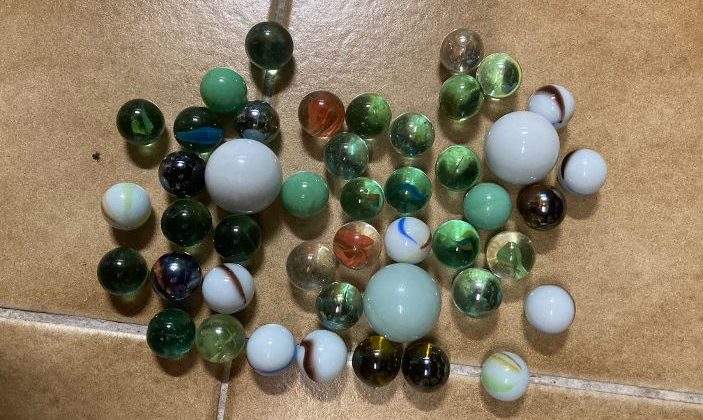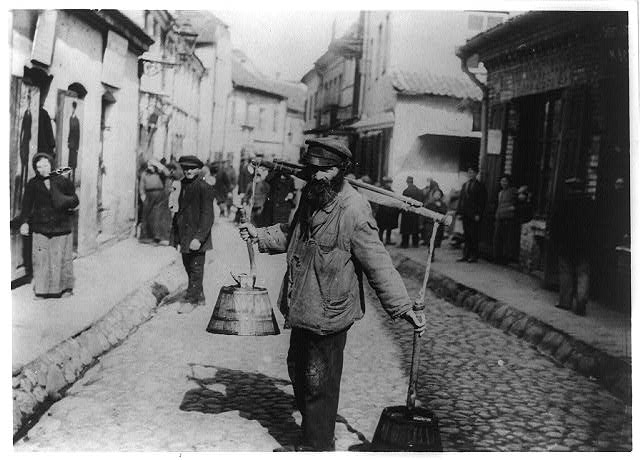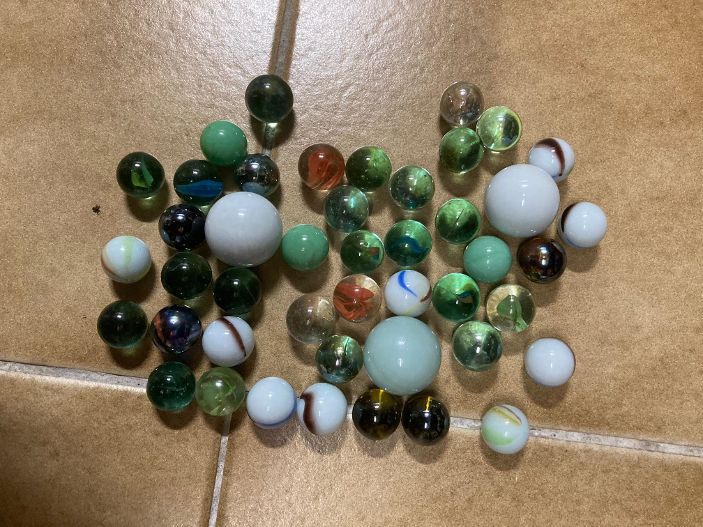
Courtesy of Bart Hendrickx, Faculty of Arts and Philosophy – Ghent University,Ghent, Belgium
Co-Author: Wendy Leyn, Zandvoorde (Zonnebeke), West Flanders, Belgium
Editors: It is with deep sadness that we tell you that our dear friend Wendy Leyn has died due to heart failure. Wendy was a friend, a colleague, and one of the most dedicated and tenacious researchers that it has been our pleasure to work with. Wendy is missed and the marble community has lost a valued friend.
We first introduced Wendy Leyn in the story Dimple Shooting in Belgium[1] and we followed that first story with a couple more “Dimple” posts. Wendy has been working with others in the Zandvoorde area to set up a marble festival and he has been working hard to build up a physical and digital library of marble-related stories; academic articles; marble books of all kinds; references; and all things related to marbles worldwide.
The heart of the research for this story is the result of Wendy’s dogged and determined research. We used email to exchange ideas and research with Wendy.
Marbles Are Forever
Wendy: This article, “Marbles are Forever”, claims that there are hardly any marbles in Russia since the Russian Revolution.[2]
Jo & Larry: The article that Wendy cites is focused on Vacor de Mexico in Guadelajara, Mexico. It does contain some information on that company which we do not remember ever seeing before.
But wait a minute! Everyone knows that marbles, marble games, and plain old marble fun are scattered world-wide. Right? Every country has a history of marbles: they form a part of each nation’s life ways. Every marble enthusiast knows this.
The article explains that “playing marbles is seen as pedagogically sound: it helps motor coordination, everyone can participate and the children must learn to set rules in advance, they learn to negotiate. An additional advantage is that marbles are not dangerous.” Not dangerous?
No Marbles in Russia?
Here is the direct quote from the article about the lack of Russian marbles: “It is striking that in a country like Russia marbles are completely unknown, the tradition was completely lost there during the revolution. [A Vacor sales representative notes that] ‘When we visit a fair there, the children look fascinated at the glass balls, but they have absolutely no idea what marbles are for. The parents don’t know it either, only some grandparents vaguely remember something.”
Wendy: It is an article of the Year 2000. I’ m asking myself: what about the situation in 2023? …And is it also true that children and adults in Russia are ignorant of the marble game(s)? If it is true why?
Jo & Larry: So, the working premise of this story is that children do not play with marbles in Russia in the traditional sense. That is, no ringer, marble shooting, and no dimples like in Belgium. No marble clubs and no tournaments. Further, marbles are generally not on sale in Russian toy stores although they can be bought internationally online. Since the Russian Revolution, children in Russia know little about marbles.
A New & Very Different Marble Story
Wendy: Frankly speaking, I don’t believe it. We need to look for evidence.
Jo & Larry: We agreed with Wendy that there has to be more to this story and then he went to work researching a particularly difficult topic and one which we have never seen covered in any story or academic article about marbles!
1917 Russian Revolution & Civil War
Early in our research we noted what appeared to be a watershed in regard to children and marbles in Russia. And that was the Revolution in the spring of 1917. Of course, there was unrest all across Russia as early as the middle of the 19th century.
But in the fall of 1917 Decrees on Land were issued by the new Bolshevik government and these decrees abolished private property. “Subsequent workers’ decrees outline measures for an eight-hour working day, minimum wage and the running of factories. … The Russian Civil War rages until the Bolsheviks consolidate power, forming the Union of Soviet Socialist Republics on December 30, 1922.”[3]
History informs us that the time directly after the formation of the USSR was a brutal and desperate time all across Russia. We have no intention to minimize the effects of this suffering on the Russian people nor do we intend to trivialize it in any way. But since this point in time was mentioned in our early and subsequent research, we cannot ignore it altogether.

Jewish water carrier standing in street in Vilna, Russia, 1922
Library of Congress Prints & Photographs Online Catalog: LC-USZ62-96010
This Report Is From Britannia[4]:
“As many as 10 million lives were lost as a result of the Russian Civil War, and the overwhelming majority of these were civilian casualties. Thousands of perceived opponents of the Bolsheviks were murdered by the Cheka [secret police], and life among the peasants was miserable.
Disease, particularly typhus, was rampant, and malnutrition was the natural consequence of Lenin’s widespread grain confiscations. The almost complete breakdown of transportation made it impossible to distribute even those inadequate supplies that the government made available.
… the railway system, which spent much of the war under the control of White Armies, was devastated. In the cities, wooden houses were pulled down to serve as fuel, and urban workers—ostensibly the foundation of the Soviet government—began to vanish back to the countryside.”
So, is it true that marbles and marble tradition were completely lost in Russia during the turmoil of the revolution? And, if so, why were marble traditions not recovered when the socio-political and economic situation improved?
More Research: Embassy of Belgium[5]
The first week of August 2023 Wendy emailed Natasha Mikhneich. Ms. Mikhneich is Administrative Assistant of the agency in Moscow of Flanders Investment and Trade and FIT is the Economic and Trade Representation for the government of Flanders.
“We don’t think that marble games are popular in Russia. Actually, it seems that none of our colleagues or acquaintances have heard anything about this issue.
I personally remember these marbles from my Soviet childhood (over 60 years ago!!): these glass balls were very, very appreciated by children, because they were beautiful and rare, but I don’t remember any “marble games” with them – their value was just the possession of a treasure.”
Ok, marbles did and do exist in Russia. But they are scarce; children do not play traditional marble games, and, there is no Russian word for marbles. The lack of Russian marbles isn’t a joke at all! This information is firsthand and it dates to the early 1960s. And notice that Ms. Mikhneich writes that these “glass balls” were rare and considered a treasure.
Glass Balls?
We all noticed early in our research that source material from Russia always references “glass balls” rather than “marbles”. Even extemporaneous Russian social media blogs and chats about marbles fail to use the word marble.
To learn more about this curiosity, Wendy wrote to Dr. Michel De Dobbeleer, Translation and Intercultural Transfer, at the Antwerp, Belgium, campus of Katholieke Universiteit Leuven (KU Leuven). KU Leuven is a Catholic research university in the city of Leuven, Belgium. We were all curious about the apparent lack of a Russian word for marbles.
Professor De Dobbeleer reviewed a number of the sources that we reference in this post and he wrote in part: “For me it’s been since primary school that I still played marbles (1980s). Although my children have (a few) marbles, they mainly serve to test marble runs with them, not to play marbles against each other.
…It is abundantly clear that it is not true that marbles disappeared in Russia during the Russian Revolution [emphasis added]. The Soviet children apparently loved the game (and the marbles themselves). … Young Russians (thus post-Soviet Union) are now less familiar with the game and/or the ‘object’ than we (/our children) in the West…”
This supports what we have learned so far about marbles in Russia today. On the other hand, we do wonder which “game” Dr. De Dobbeleer refers to. And, if they are testing marble runs with marbles, then don’t they also run marbles?[6]
Daddy, Buy Me Some Sharik Please?
Dr. De Dobbeleer next turns to the word “marbles” in Russian. “The English-derived term марбл (marbl), .. is not in my Russian-Dutch dictionary. The clearly … more common term шарик (sharik; also the word for ‘ball’ and incidentally a very frequent dog name) is included, also with the more specific meaning of ‘marble’.
I find it very curious that my Dutch-Russian dictionary gives кникер (kniker) as well as шарик for ‘knikker’. …Marbles were not completely unknown in Russia (or at least among Russian speakers) after the fall of the Soviet Union. “
Bottom Line
Well, the bottom line is this: there is no Russian word for marbles! In Chapter one, “Where do marbles come from and why?” of our book The Secret Life of Marbles we offer a comprehensive analysis of the origins both of the word “marbles” and of the games played with them. We know that the word marbles was first used in the early 18th century, but it is probably older than that.
Marbles and marble games predate the Russian Revolution by centuries. Didn’t Russian children know and play with marbles early on in Russian history? Again, all we can do is establish the fact that there is no formal nor colloquial Russian word for marbles. “Glass balls” is used consistently.
Wow, What A Lot of Books!
Early in our research we all became acquainted with the massive The Great Soviet Encyclopedia (GSE). This GSE “…is one of the largest Russian-language encyclopedias, published by the Soviet state from 1926 to 1990, and again since 2002 by Russia (under the name Bolshaya Rossiyskaya entsiklopediya or Great Russian Encyclopedia).
The GSE is in three editions: the first has 65 volumes (65,000 entries), the second is 50 volumes (100,000 entries), and the third is 30 volumes (another 100,000 entries)![7]

None of us could possibly check over a quarter million entries to search for the word “marbles” in Russia since 1926. So, Wendy wrote Professor Bart Hendrickx , Faculty of Arts and Philosophy, Ghent University, about the GSE.
Professor Hendrickx sent us this photograph. He explained that these marbles are probably ones which he bought for his children rather than ones he played with as a child. However, as we will discuss later, the transparent marbles in different colors are in fact the very type “glass balls” which can be found all across Russia today.
Professor Hendrickx & the GSE
As for the GSE Professor Hendrickx writes:
“In that large Soviet encyclopedia (which can be consulted online) there is no article on marbles, at least not under the names “marbles” or “glass balls” (I don’t know what else to look under). I find most information when I google “стеклянные шарики” (glass balls) (using the quotes to get that specific combination) in combination with СССР (USSR).[8]
What is clear from those GSE entries is that marbles were not available in toy shops in Soviet times, so they were not sold as toys. Glass balls were needed (still today, by the way) for certain production processes (eg for making glass fibers) and then ended up as “waste” in industrial areas or near railways (if they had to be transported).
Workers sometimes took them home to use as decorations (e.g. in aquariums) or children simply went looking for them in those places. They were considered to be something precious and were often used as a medium of exchange by children. Apparently there were also all kinds of myths about where they came from.”
Sounds Just Like Down Home
There at least three key ideas in Dr. Hendrickx’ email. First is the similarity to our own experiences in looking for marbles. Both Russian and American fathers took “glass balls” home from work on the railroads and from factories of all kinds.
Often they were treated as waste by the manufacturers and they were dumped. Children found them and treasured them. And we have found them just in the last few years.
Now the very odd part. Russian children did not take these found treasures and play marble games with them! They traded them. But they did not design competitive games and play for keeps!
This seems odd indeed. Rather than trade or barter, it seems that children would have learned to play competitively and in that way exchange marbles.
And finally, apparently an entire mythology arose about where these glass balls come from! Popular Russian social media continues to build and add to this myth today. Larry thinks that at least some of these social posts are preposterous and some simply read like fiction or mythology.
Russian Social Media
To an extent Russian social media today reflects what Professor Hendrickx reports. Wendy writes this about marbles in Russian social media:
“Whoever wrote them knows … well what marbles are, but calls them glass balls …. The marbles / glass balls were not bought in the past, they were probably not even for sale.
They were found, taken from factories, or bartered because they had exchange value. Marbles used to be a product of various production processes, not only semi-finished products for fiberglass, but also as stoppers for bottles and for paint pots.
Glass balls are now for sale in shops for aquariums, children’s shops,…. It also seems clear that the children + adults not only collected them, but also played and played with them. Various game forms and techniques are cited. ….[Glass balls] also serve as house+table decoration and are used in aquariums and flower arrangements/vases.”
Now back to Professor Hendrickx
“I suspect that the word “marbles” only appeared in Russian in the years after the fall of the USSR (or even after the turn of this century), when they also became commercially available as toys, but probably mainly through foreign online shops. I doubt if they are produced in Russia itself. Many people who grew up in the Soviet era will remember them, but I don’t think marbles are a well-known phenomenon among today’s youth.”
Who You Gonna Call?[9]
Well, at this point in our search for Russian marbles we have learned that there is no more solid evidence than experts, specialists, and academicians. There is no better source of information than those with firsthand knowledge.
“You will always be a stranger”[10]
In an attempt to gain more information from experts Wendy emailed Vladimir Ronin. Dr. Ronin is a Russian expat with a PhD in History and a Master’s Degree in Slavisitics. He currently teaches at the University of Leuven campus in Antwerp, Belgium. He is a respected scholar and writer.
Dr. Ronin had this to say about Russian marbles:
“In any case, being born and raised in Russia, I have never heard of playing marbles in my homeland, not even among children. To my knowledge, it was also never mentioned in 19th century Russian literature, so I don’t think it has anything to do with the 1917 revolution. We don’t even have a Russian word for the actual marbles. What was and remains popular in Russia is skittles, nowadays in the form of indoor bowling adopted from the USA variant of skittles (gorodkí) is even considered a traditional, typically Russian game. Due to the popularity of different forms of the game of skittles, marbles just didn’t get a place in my opinion.”
Skittles
We find Dr. Ronin’s contribution fascinating. First, he confirms our findings that while marbles (glass balls) are known in Russia they are not popular now nor have they been even in pre-Soviet times. Second, while the Russian Revolution was a watershed moment for the country it was not causative in preventing children from playing marbles.
And finally we had never heard about Russian skittles. In Chapter One of our book The Secret Life of Marbles (pages 3 – 6) we report that a skittles game which used marbles was excavated from a Pre-Dynastic Egyptian grave in the late 19th century.
Not The End!
We have collected a body of resources relating to marbles in Russia. We cannot find another story, Blog, academic or archaeological paper on this topic: do children or adults in Russia play with marbles in the traditional sense?
Well, while we have more to say on the topic in our next story “Searching for Nikolai’s Marbles: Part 2”, we want to summarize what we have learned so far.
Although none of us has done actual field work in Russia and although researchers living in Russia are very difficult to contact, we have established a number of working hypotheses:
- There is a paucity of marbles in Russia today. Marble gaming by children or adults in the traditional sense is not popular there.
- Game or toy marbles are not manufactured in Russia.
- Marbles can be bought online and Vacor de Mexico marbles are a popular choice. While collected and treasured, these marbles are not viewed as toys.
- Marbles are, as a general rule, not available in toy shops.
- There is no Russian word for “Marble”. “Glass balls” are the substitute words applied to toy marbles.
- When children collect these glass balls (for example from industrial waste sites or from their parents who take them from factories and workshops) the children save them and sometimes trade or barter them, but they do not organize games of ringer or dimples.
To be continued in part 2.
- https://thesecretlifeofmarbles.com/dimple-shooting-in-belgium/ 8/15/2023 ↑
- The article, “Marbles are Forever,” was published in De Tijd which is a reliable reference newspaper published in Brussels, Belgium. Reference: https://www.tijd.be/algemeen/algemeen/een-knikker-is-voor-altijd/5273964.html?fbclid=IwAR2U8kziEOD4WaAYpIdYy0Cfqy8N4jsnQ_sVezRDKzkFUqzt_q4Mp6oIsw0 8/15/2023 ↑
- The University of Miami maintains a website which lists dozens of books, movies and art about the revolution and the following social unrest at https://miamioh.edu/cas/centers-institutes/havighurst-center/additional-resources/havighurst-special-programming/1917-centennial/index.html ↑
- https://www.britannica.com/event/Russian-Civil-War/Foreign-intervention 8/15/2023 ↑
- Explication: Belgium is politically a very complicated land; there are great sensibilities which are difficult to grasp for most people, see: https://en.wikipedia.org/wiki/Communities,_regions,_and_language_areas_of_Belgium 8/18/2023 ↑
- To learn more about marble runs check: https://en.wikipedia.org/wiki/Rolling_ball_sculpture 8/17/2023 ↑
- https://encyclopedia.pub/entry/32049 8/10/2023 ↑
- Professor Hendrickx refers us back to research we had located earlier: https://dzen.ru/a/YWNA_ERJQywANrmD ↑
- We tip our hat to Ray Parker, Jr. for “Ghostbusters” is a song written as the theme to the film of the same name, and included on the film’s soundtrack. ↑
- https://www.vrt.be/vrtnws/en/2011/07/20/_you_will_alwaysbeastranger-1-1040372/ 8/17/2023 ↑

